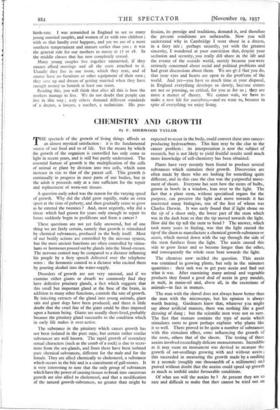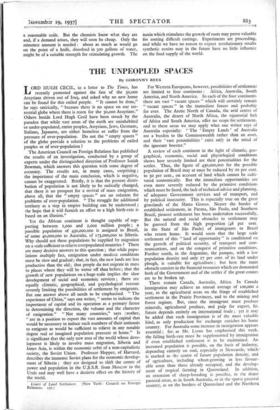CHEMISTRY AND GROWTH
By F. SHERWOOD TAYLOR
THE spectacle of the growth of living things affords us an almost mystical satisfaction : it is the fundamental source of our food and so of life. Yet the means by which the growth of the organism is controlled has only come to 'light in recent years, and is still but partly understood. The essential feature of growth is the multiplication of the cells of animal or plant by division into two cells, which soon increase in size to that of the parent cell. This growth is continually in progress in most parts of our bodies, but in the adult it proceeds . only at a rate sufficient for the repair and replacement of worn-out tissues.
A question early asked was the reason for the varying speed of growth. Why did the child grow rapidly, make an extra spurt at the time of puberty, and then gradually cease to grow as he entered the twenties ? And, most urgently, why did a tissue which had grown for years only enough to repair its losses suddenly begin to proliferate and form a cancer ?
These questions are not yet fully answered, but of one thing we are fairly certain, namely that growth is stimulated by chemical substances, produced in the body itself. Most of our bodily actions are controlled by the nervous system, but the most ancient functions are often controlled by stimu- lants or hormones poured out by glands into the blood-stream. The nervous control may be compared to a dictator inflaming his people by a fiery speech delivered over the telephone wires : the hormonic control to a dictator who excited them by pouring alcohol into the water-supply.
Disorders of growth are not very unusual, and if we examine either giants or dwarfs we commonly find they have defective pituitary glands, a fact which suggests that this small but important gland at the base of the brain, in addition to many other functions, controls the rate of growth. By injecting extracts of the gland into young animals, giant rats and giant dogs have been produced, and there is little doubt that the cruel fate of the giant could be thus imposed upon a human being. Giants are usually short-lived, probably because the pituitary gland succumbs to the-condition which in early life makes it over-active.
The substance in the pituitary which causes growth has not been isolated in the pure state, but certain rather similar substances are well known. The rapid growth of secondary sexual characters (such as the comb of a cock) is due to secre- tions from the sex-glands, and from these have been isolated pure chemical substances, different for the male and for the female. They are allied chemically to cholesterol, a substance which occurs in the bile and is a constituent of gall-stones. It is very interesting to note that the only group of substances which have the power of causing tissues to break into cancerous growth are also allied to cholesterol, and that a modification of the natural growth-substances, no greater than might be expected to occur in the body, could convert these into cancer- producing hydrocarbons. This hint may be the clue to the cancer problem : its interpretation is now the subject of research, but is not likely to yield fruitful results until much more knowledge of cell-chemistry has been obtaiiied.
Plants have very recently been found to produce several substances which stimulate their growth. Discoveries are often made by those who are looking for something quite different, and in this case the clue was the purposeful move- ment of shoots. Everyone has_ seen how the stems of bulbs, grown in bowls in a window, lean over to the light. The fact that a plant stem, without specialised organs for the purpose, can perceive the light and move towards it has interested many biologists, one of the first of whom was Charles Darwin. It was early found that if light shone on the tip of a shoot only, the lower part of the stem which was in the dark bent so that the tip moved towards the light. How did the tip tell the stem to bend ? The answer, which took many years in finding, was that the light caused the tip of the shoot to manufacture a chemical growth-substance or auxin, which moved down with the sap through the side of the stem furthest from the light. The auxin caused this side to grow faster and so become longer than the other, and consequently the whole stem bent towards the light.
The chemists now tackled the question. This auxin was contained in growing plants, but only in the minutest quantities • their task was to get pure auxin and find out what it was. After examining many animal and vegetable products they found a good deal of auxin in grey moulds, in malt, in maize-oil and, above all, in the excretions of animals—in fact in manure.
The man with the shovel does not always know better- than the man with the microscope, but his opinion is always worth hearing. Gardeners knew that, whatever you might say about artificial manure, there was nothing like a good dressing of dung ; but the scientific men were not so sure. The fact that manure contains the type of auxin which stimulates roots to grow perhaps explains why plants like it so well. There proved to be quite a number of substances with this stimulant effect, some influencing the growth of the roots, others that of the shoots. The testing-of these auxins involved exceedingly delicate measurements. Incredible as it may seem an instrument was devised to measure the growth of oat-seedlings growing with and without auxin ; this succeeded in measuring the growth made by: a seedling in 5 seconds (roughly one thousandth of a millimetre) ani proved without doubt that the auxins could speed up growth as much as tenfold under favourable conditions.
Of what use will the auxins be ? At present they are so rare and difficult to make that they cannot be tried out on a reasonable scale. But the chemists know what they are and, if a demand arises, they will soon be cheap. Only the minutest amount is needed : - about as much as would go on the point of a knife, dissolved in 300 gallons of water, might be of a suitable strength for stimulating growth. The auxin which stimulates the growth of roots may prove valuable for rooting difficult cuttings. Experiments are proceeding, and while we have no reason to expect revolutionary results synthetic auxins may in the future have no little influence on the food supply of the world.

















































































































 Previous page
Previous page